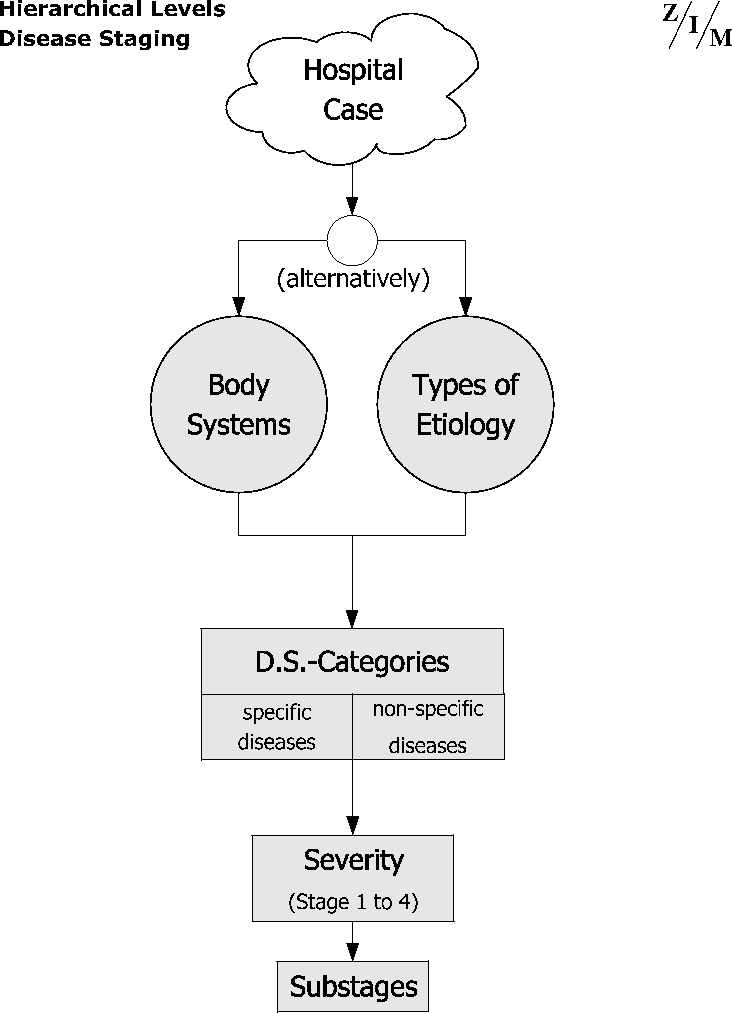|^·<×>·v| |
G.1 |
|
Disease Staging
|
1 |
|
|
Table 1:
Hierarchical levels of Disease Staging
|
|
2 |
|
|
|
Source: Fischer [DRGs im Vergleich, 1999]: 46. |
|
1
Gonella et al. [DS-ClinCrit, 1994];
Gonella et al. [Disease Staging, 1984].
|
|
Physicians as experts |
The development of the D.S. system1
began in the late 70s,
at about the same time as DRGs (Diagnosis Related Groups).
Unlike in the case of DRGs,
the D.S. concept is based on a purely medical expert approach,
and not upon statistical considerations. |
3 |
|
|
Diseases |
The system describes "diseases".
Each disease is considered to run through various "stages".
Inspired from the disease staging concept known in oncology,
medical consultants have defined stages
for 372 clinical conditions.
In addition, 224 categories for not specifically defined conditions
are present
(e. g. "other malignant neoplasms of the circulatory system",
"not otherwise specified heart diseases",
"unspecified heart diseases" etc.). |
4 |
|
|
Stage of disease |
The disease stage is derived from all the diagnoses
that were collected during the hospital stay of a patient.
It is related to the mortality risk
or the risk of retaining a disability from the disease.
The treatment intended is not considered.
(This allows for clear distinction between patient problems and
therapy characteristics!) |
5 |
|
|
|
|
|
|
|
|
The stages are as follows:
- Stage 1:
A disease with no complications.
- Stage 2:
The disease has local complications.
(The problem is limited to an organ or body system;
there is a significantly increased risk of complications.)
- Stage 3:
The disease involves multiple sites, or has systemic complications.
(Prognosis is bad.)
- Stage 4:
Death (occurred during the hospital stay).
|
6 |
|
|
Differentiating DRG cost weights |
Often, the D.S. system was used to demonstrate inhomogenity of DRGs.
This task is facilitated through the D.S. system's software,
using a special index: The "DRGSCALE" figure shows,
how much the cost weight of an individual hospital stay deviates
from the DRG-related average value. |
7 |
|
|
|
|
|
|
|
References |
|
|
| -
Fischer
- DRGs im Vergleich
1999
| Fischer W. Diagnosis Related Groups (DRGs) im Vergleich zu den Patientenklassifikationssystemen von Deutschland und Österreich. Eine problemzentrierte Diskussion von Patientenklassifikationssystemen für stationäre Akutbehandlungen im Hinblick auf deren Verwendung in Vergütungssystemen. Wolfertswil (ZIM) 1999: 155 pp. Auszüge:
http:// www.fischer-zim.ch / studien / DRGs-im-Vergleich-9901-Info.htm. | 8 |
|
| -
Gonella et al.
- Disease Staging
1984
| Gonella JS, Hornbrook MC, Louis DZ. Staging of Disease. A Case-Mix Measurement. In: JAMA 1984(251)5: 637–644. | 9 |
|
| -
Gonella et al.
- DS-ClinCrit
1994
| Gonella JS, Louis DZ, Marvin EG. Disease Staging: Clinical Criteria. Fourth Edition, Ann Arbor (MEDSTAT Systems) 1994: 834 pp. | 10 |
![[print]](../PIC/e-div/print.gif)
![[pdf icon]](../PIC/e-div/pdf.gif) Whole Text as pdf file
(1020 KB)
Whole Text as pdf file
(1020 KB) Kurz-Info: Disease Staging (USA)
Kurz-Info: Disease Staging (USA)